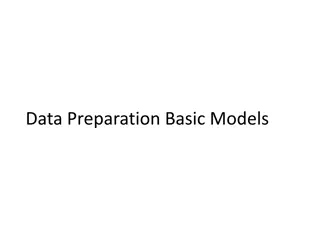Normalisation
Explore databases in detail and understand normalization. Learn how to structure data efficiently in databases for optimal performance. Research and discuss the importance of normalization.
1 views • 20 slides
Building a local facet in Primo VE for Decolonization work
Explore the process of adding publisher/place of publication as a search parameter in Library Search, with insights on using MARC fields, establishing normalization rules, and steps to enable and translate local fields for effective faceted searching in Primo VE. Learn about the nuances of field rec
0 views • 19 slides
fMRI Coregistration and Spatial Normalization Methods
fMRI data analysis involves coregistration and spatial normalization to align functional and structural images, reduce variability, and prepare data for statistical analysis. Coregistration aligns images from different modalities within subjects, while spatial normalization achieves precise anatomic
3 views • 35 slides
Understanding Amazon EC2: Elastic Compute Cloud Fundamentals
Amazon Elastic Compute Cloud (EC2) is a web service provided by Amazon Web Services (AWS) that offers resizable compute capacity in the cloud. EC2 allows users to rent virtual servers known as instances to run applications. Key features include various instance types, Amazon Machine Images (AMIs), s
11 views • 5 slides
Coregistration and Spatial Normalization in fMRI Analysis
Coregistration and Spatial Normalization are essential steps in fMRI data preprocessing to ensure accurate alignment of functional and structural images for further analysis. Coregistration involves aligning images from different modalities within the same individual, while spatial normalization aim
6 views • 42 slides
Struggling with Data Accuracy_ Implement These Data Cleansing Techniques in Your BI Software
Explore essential data cleansing techniques that can significantly improve the accuracy and reliability of your Business Intelligence software. This guide offers practical advice on implementing normalization, deduplication, validation, and more, ensuring that your data is not just voluminous but tr
7 views • 7 slides
Using BIBFRAME in a mixed MARC environment
Delve into the intricate world of utilizing BIBFRAME alongside MARC standards at the National Library of Sweden. Discover the benefits of a BIBFRAME catalog, the challenges of maintaining dual terminology, and the ongoing shift towards linked data integration. Gain insights into cataloging practices
0 views • 10 slides
The Impact of Media on Shooting Sports Engagement
Communication trends are shifting back to print media, especially among Gen Z, impacting the perception of information trustworthiness. The rise of digital platforms has allowed for greater dissemination of information, positively impacting the visibility and normalization of shooting sports. Howeve
2 views • 11 slides
Understanding Patient Health Record Linkage Methods
Explore the methods and processes involved in linking patient health records to ensure data accuracy and integrity. Learn about objectives, data de-duplication, encryption, data normalization, and linkage variables. Discover CU Record Linkage (CURL) data flow and key quality measures. Dive into data
2 views • 21 slides
Database Normalization and Aggregation Concepts
Understanding the advantages and disadvantages of database normalization, the concept of aggregation in the ER model, and examples of creating ER diagrams using aggregation rules with related entities. Explore the benefits of smaller databases and better performance through normalization, and how ag
4 views • 11 slides
Understanding Approximation Algorithms: Types, Terminology, and Performance Ratios
Approximation algorithms aim to find near-optimal solutions for optimization problems, with the performance ratio indicating how close the algorithm's solution is to the optimal solution. The terminology used in approximation algorithms includes P (optimization problem), C (approximation algorithm),
2 views • 10 slides
Understanding Database Normalization and Functional Dependencies
Database normalization is a crucial process that aims to improve database design by organizing data into higher forms of normality. This helps in reducing redundancy and ensuring data integrity. Functional dependencies play a key role in defining relationships between attributes in a database. By un
0 views • 33 slides
Database Design Process and Concepts
This lecture on designing databases covers the database design process, normalization, transforming E-R diagrams, physical database design concepts, and steps in logical database modeling. It highlights the importance of logical and physical database design in system development, providing insights
0 views • 64 slides
Understanding Probabilistic Retrieval Models and Ranking Principles
In CS 589 Fall 2020, topics covered include probabilistic retrieval models, probability ranking principles, and rescaling methods like IDF and pivoted length normalization. The lecture also delves into random variables, Bayes rules, and maximum likelihood estimation. Quiz questions explore document
0 views • 53 slides
Methods of Mark Adjustment in Educational Assessment
In educational assessment, methods like Z-score normalization, quadratic scaling, and piecewise linear scaling are used to adjust marks based on Gaussian distribution assumptions. Z-score normalization helps to adjust both mean and standard deviation, impacting the distribution of marks. Quadratic s
4 views • 25 slides
Understanding 2D Viewing in Computer Graphics
Exploring the concept of 2D viewing in computer graphics, this lecture covers the 2D viewing pipeline, including clipping, window normalization, viewport transformations, and OpenGL 2D viewing functions. It explains how a picture is defined using a Cartesian coordinate system, selecting views within
2 views • 84 slides
Understanding Data Flow in Machine Learning Systems
Explore the intricate data flow within machine learning systems through the stages of data design, model building, data cleaning, and evaluation. Learn about the importance of data types, training data, and data normalization in creating effective machine learning models.
0 views • 27 slides
Parents Can Help Teens and Young Adults Say No to Drugs
Normalization of substance use, consequences of substance abuse, adolescent development vulnerabilities, parent-child attachment significance, and the need for parental guidance to prevent substance abuse amongst teens and young adults are discussed.
0 views • 28 slides
Understanding Database Normalization Process
Database normalization is a crucial process that helps in organizing data efficiently by reducing redundancy and dependency issues. It involves steps like identifying keys, removing repeating attributes, and transforming data into different normal forms. Each step aims to enhance data integrity and
0 views • 19 slides
Medication Administration Process and Staff Responsibilities Overview
Detailed information on medication administration process, responsibilities of staff members, and general guidelines for ensuring safe and effective medication management. The process involves prescribing medication, filling prescriptions, monitoring the individual, assistance in administration, and
0 views • 62 slides
FlashNormalize: Programming by Examples for Text Normalization
Text normalization is essential for converting non-standard words like numbers, dates, and currencies into consistently formatted variants. FlashNormalize offers a programming-by-examples approach for accurate normalization, addressing challenges posed by traditional manual methods and statistical t
6 views • 14 slides
Understanding Normalization in Database Management
Normalization is a crucial database design technique used to organize tables efficiently, reduce data redundancy, and prevent anomalies in data operations. This process involves decomposing larger tables into smaller, linked tables to ensure consistency and ease of data management.
1 views • 59 slides
Database Normalization: Understanding Sets and Normal Forms
Explore the importance of set theory in database design, learn about different types of sets, subsets, and supersets, understand the basics of normalization techniques to efficiently organize data in databases, and discover the common anomalies associated with unnormalized databases.
0 views • 26 slides
Understanding Data Preparation in Data Science
Data preparation is a crucial step in the data science process, involving tasks such as data integration, cleaning, normalization, and transformation. Data gathered from various sources may have inconsistencies in attribute names and values, requiring uniformity through integration. Cleaning data ad
1 views • 50 slides
Effect of Normalization of Relations with Cuba on Georgia
The normalization of relations with Cuba has had significant effects in Georgia, particularly in terms of diplomatic relations, trade embargo laws, and trade relations. This includes a look at the naming of ambassadors, the importance of diplomatic relations, trade restrictions with various countrie
0 views • 8 slides
Understanding Database Normalization: A Comprehensive Guide
Database normalization is a crucial process in database design to eliminate data redundancy and anomalies. This guide covers the definition of normalization, types of normalization including 1NF, 2NF, and more, along with examples and explanations on achieving each normalization form.
1 views • 22 slides
Understanding Database Normalization Techniques
Database normalization is a crucial technique for organizing data efficiently to eliminate redundancy and anomalies. It involves decomposing tables to ensure data integrity and minimize inconsistencies. Common issues without normalization include excessive memory usage and data manipulation problems
4 views • 21 slides
Enhancing Counterfactual Explanations for Improved Understanding
This article explores the concept of generating interpretable, diverse, and plausible counterfactual explanations within explainable AI (XAI). It highlights the challenges with current methods, introduces an instance-guided approach, and emphasizes the importance of good counterfactuals. The discuss
0 views • 22 slides
Evolution of Style-Based Generator Architecture in GANs
Evolutionary advancements in GAN generators, such as the progressive GAN setup and adaptive instance normalization, have led to improved image synthesis quality. Inspired by style transfer networks, these models enhance training efficiency and style transfer capabilities, revolutionizing the field o
0 views • 26 slides
Introduction to Instance-Based Learning in Data Mining
Instance-Based Learning, as discussed in the lecture notes, focuses on classifiers like Rote-learner and Nearest Neighbor. These classifiers rely on memorizing training data and determining classification based on similarity to known examples. Nearest Neighbor classifiers use the concept of k-neares
0 views • 13 slides
Updating Product Instance: Gearbox Revision and Primary Gear Change
This process involves updating a product instance by revising the gearbox and switching the primary gear from serial PG02 to PG03. Steps include revising the instance, deallocating the primary gear, allocating a new or existing serial number for the primary gear, updating Instance 001 Revision B, an
0 views • 7 slides
Understanding Classes and Objects in Java Programming
Explore the fundamentals of Java classes and objects, including defining classes, instance variables, methods, constructors, accessors, mutators, static vs instance members, creating and calling methods, encapsulation, object-oriented design principles, and designing custom classes for specific task
0 views • 26 slides
Best Practices in Neural Network Initialization and Normalization
This resource provides practical advice on input normalization, weight initialization, Xavier normalization, and Glorot/Bengio normalization in neural networks. Tips include the importance of controlling the range of net inputs, setting initial weights appropriately, and understanding the rationale
0 views • 15 slides
Understanding Information Retrieval Techniques
Information retrieval involves various techniques such as stop words exclusion, normalization of terms, language-specific normalization like accents and date forms, and case folding to enhance search efficiency. These methods aim to improve query matching by standardizing and optimizing indexed text
0 views • 9 slides
Understanding Batch Normalization in Neural Networks
Batch Normalization (BN) is a technique used in neural networks to improve training efficiency by reducing internal covariate shift. This process involves normalizing input data to specific ranges or mean and variance values, allowing for faster convergence in optimization algorithms. By standardizi
0 views • 18 slides
Scan and Fix: Indication and Normalization Rules in Alma
Introduction to indication rules and normalization rules in Alma Miriam C. Nauenburg's presentation on the scan and fix workflow. Learn about creating and applying indication and normalization rules, testing rules in the Metadata Editor, and organizing rules as private or shared.
0 views • 54 slides
E-R Diagram and Normalization Analysis for Online Telephone Sales System
This content provides detailed information on the creation of an information system for tracking orders in an online telephone sales company. It includes system requirements, entity identification, attribute listing, relationship identification, and normalization analysis for second and third normal
0 views • 10 slides
Understanding Discriminative Normalization Flow in Machine Learning
Explore the intricacies of Discriminative Normalization Flow (DNF) and its role in preserving information through various models like NF and PCA. Delve into how DNF encoding maintains data distribution and class information, providing insights into dimension reduction and information preservation in
0 views • 23 slides
Understanding Relational Database Design Fundamentals
This content delves into the crucial aspects of relational database design, including normalization, pitfalls, RDBMS design issues, and the overall database design process. It emphasizes the need for well-structured relation schemas to minimize redundancy, ensure data integrity, and facilitate effic
1 views • 53 slides
Understanding Database Normalization and BCNF in Database Systems
Learn about the process of database development, including E-R diagrams, converting to relations, developing database operations, normalization, and BCNF. Explore algorithms for achieving BCNF and example scenarios to understand key concepts in database systems.
0 views • 43 slides







































